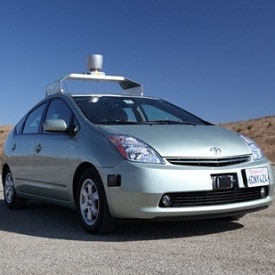
You may have heard that Nevada, with its wide open spaces, was adopting a driverless vehicle program, but now California state Senator Alex Padilla, a Democrat representing Pacoima, has introduced legislation requiring the Department of the California Highway Patrol to "adopt safety standards and performance requirements to ensure the safe operation and testing of autonomous vehicles… on the public roads."
If you're wondering whether autonomous vehicles are ready for California traffic, PCMag.com reported that Padilla arrived at the press conference to announce the bill in a modified Toyota Prius that drove at least part of the route without driver intervention. Furthermore, says the PC Mag report, cars modified to drive themselves with state of the art Google sensors, GPS, and computing power have already driven more than 200,000 miles on California roads.
If they are already sharing the road with human drivers, why the need for new rules? According to the text of Padilla's bill, California law does not currently prohibit or regulate the operation of autonomous vehicles on public roads. The new law would simply establish a set of basic safety requirements that must be met to the satisfaction of the California Highway Patrol before any robot car is set loose on the roads of California. While Google has a track record of safe operation of autonomous vehicles, there are currently no rules preventing someone like TV's "Myth Busters" from rigging up a self-driving car and letting it run down the highway during rush hour.
Meanwhile, the mainstream auto-industry has been taking baby steps toward self-driving cars for last few years with technology enhancements like self-parking vehicles, adaptive cruise control, lane keep assistance, and automated emergency braking systems. These features have been readily accepted by drivers as safety enhancements, but will they feel the same way when they look in the rear-view mirror and see that there's nobody behind the wheel of the car behind them?
At least it won't be tail-gating. Google's autonomous sensor system includes four radar systems to look ahead and behind the car and allow it to maintain a safe following distance. The ability of computerized control system to follow the rules and not make mistakes is one of the reasons that the driverless vehicle legislation was introduced. In his press conference Senator Padilla said, "The vast majority of vehicle accidents are due to human error… Autonomous vehicles have the potential to significantly reduce traffic fatalities and improve safety on our roads."
The bill did not give a deadline for the California Highway Patrol to come up with rules governing the use of autonomous vehicles, and until they do, the bill specifically states that autonomous vehicles will not be prohibited from the public roads of California. The next time you notice another driver being polite on the roads, look again, there might be no one there at all.
